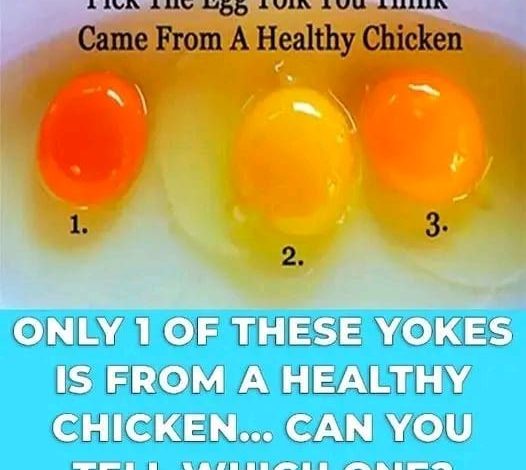Decoding Egg Yolk Colors: Indicators of Chicken Health

ADVERTISEMENT
Decoding Egg Yolk Colors: Indicators of Chicken Health
Introduction:
When it comes to assessing the health of chickens, one of the more subtle indicators can be found in the color of their egg yolks. The image presents a selection of three egg yolks, each varying significantly in color from pale yellow to deep orange, prompting the viewer to guess which one comes from a healthy chicken. This raises important questions about what yolk color really indicates about a chicken’s health and diet.
Discussion: 1. Yolk Color Variations:
- Pale Yellow (Yolk 2): Typically, a pale yellow yolk might suggest a diet low in carotenoids, which are natural pigments found in certain plants. Chickens with access to a diverse diet, including various greens and insects, tend to produce darker yolks. A pale yolk might not necessarily indicate poor health, but it could suggest a limited diet.
- Medium Yellow (Yolk 3): This is often seen in commercial eggs where chickens are fed a diet formulated to be nutritionally adequate but possibly lacking in natural variety. Such yolks are healthy enough but might not have the enhanced nutrient profile of darker yolks.
- Dark Orange (Yolk 1): Dark orange yolks are typically a sign of a rich and varied diet, high in carotenoids. These yolks can indicate chickens that are possibly free-range or have access to a high-quality diet rich in greens and other colored vegetables.
2. Nutritional Content and Implications:
ADVERTISEMENT
- Studies suggest that darker yolks might have higher omega-3 fatty acids, vitamins (such as A, D, E), and also more antioxidants. However, the nutritional difference, while present, is not vast enough to deem pale yolks unhealthy.
- The perception of health benefits linked to darker yolks has influenced consumer preferences, often associating darker, vibrant yolks with free-range or organically raised chickens.
3. Consumer Perceptions and Marketing:
- The color of an egg yolk can affect consumer preference and perception of quality. Many consumers tend to believe that darker yolks are tastier and healthier, influencing purchasing decisions.
- Egg producers might adjust diets to enhance yolk color artificially by adding marigold petals or other natural additives to feed to achieve desired yolk colors, without significantly altering the nutritional content.
Conclusion: The color of an egg’s yolk can tell us much about a chicken’s diet and, to a lesser extent, its health. While a darker yolk often suggests a richer diet and potentially higher nutrient content, it’s crucial to remember that pale yolks are not necessarily an indicator of poor health. Instead, they might simply reflect a different diet. Consumers should look at other factors such as egg freshness and farming practices along with yolk color to make informed choices about the eggs they consume.
Understanding these nuances helps in making better dietary choices and appreciating the implications of farming practices on the food we eat.




